Basic definition of Low Post series
The Low Post series of Princeton offense generally focuses on utilizing a low post player to ultimately create close-range or perimeter-oriented scoring opportunities, especially via cutting and screening actions.
Primary areas of the court occupied by players running the Low Post series
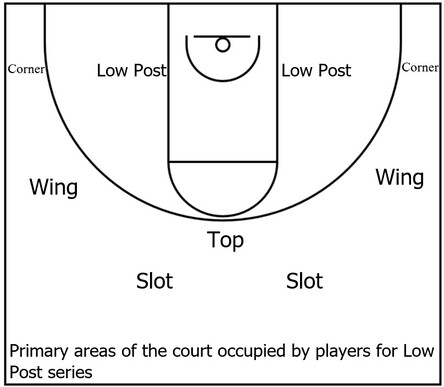
The primary areas of the court that the offensive players will usually occupy while running the Low Post series include the top, the slots, the wings, the low post, and the corners.
The adjacent diagram above displays the common spots and it should also be noted that each of those areas are spaced apart approximately 12 feet or more.
Therefore when any player fills one of these particular areas while other teammates occupy other vacant spaces, then that would be representative of good spacing, which is an important concept to understand and implement.
Essentially, good spacing makes it more difficult for the opposing defensive team to productively guard against and/or hinder offensive actions within the Low Post series.
As a result, it is possible that the offensive team would have a much easier time generating scoring opportunities near the basket or near perimeter areas of the court.
The following subsections contain brief descriptions of the pertinent areas of the court as it relates to the Low Post Series of Princeton offense.
Top
The top, sometimes referred to as top of the key or point, is the general area located behind the three-point line in the middle of the offensive team’s frontcourt.
In terms of the Low Post series, offensive players will typically occupy the top after a wing entry pass or low post entry pass.
Slots
The slots, also referred to as the lane line extended areas, are specific spots of the court that are adjacent to the top and between the wings.
Players generally fill the slot areas during the initial setup of the Low Post series. However, at specific moments within the offense, players might fill the slot to reset the offense or to execute another phase of the Princeton offense such as the Chin series or Point series.
Wings
The wings comprise areas of the court behind the three-point line that are adjacent to the nearest sideline, which is also generally at or above the free throw line extended.
Players typically occupy the wing areas during the initial setup of the Low Post series. However, a player may also fill one of the wings during certain times of the offense such as after a split cut occurs.
Low post
The low post areas are slightly above the basket and just outside of the lane lines, which are borders for the lane.
Moreover, the lane area, also referred to as the key, comprises the area that is between the low posts and below the free throw line.
In reference to the Low Post series, one particular player would usually occupy the low post area to receive the ball from a player near the wing.
Afterwards, that same post player could attempt to generate potential scoring opportunities by passing the ball to teammates, who will typically cut or screen to get open or via low post moves around the basket.
Corners
The corners consists of the areas behind the three-point line that are in the general vicinity of a sideline and its adjoining baseline.
Within the Low Post series, players will typically occupy the corner areas after cutting towards the basket and away from the ball or to simply fill the empty space on the strong side while additional offensive action occurs on the weak side.
Initial setup for the Low Post series
The most typical initial setup for the Low Post series is the 2-2-1 alignment.
This is displayed via an example diagram below.
Furthermore, in reference to the diagram within this section as well as other diagrams within later sections, each offensive player is indicated by a number that generally represents one of the standard basketball positions.
Essentially, 1 is the point guard while 2 is the shooting guard.
3 is the small forward while 4 is the power forward.
Lastly, 5 plays the role of the center position.
Additionally, it should be mentioned that within Princeton offense in general, it is possible for all five players to exchange roles on the court, which is commonly referred to a positionless team.
Nonetheless, for the Low Post series, four of the players, which are the guards and forwards, can switch roles. However, one player, which is the center, will typically stay in the same role, mainly operating from the low post area of the court.
The players will usually remain in these standard basketball roles unless stated otherwise.
2-2-1 alignment
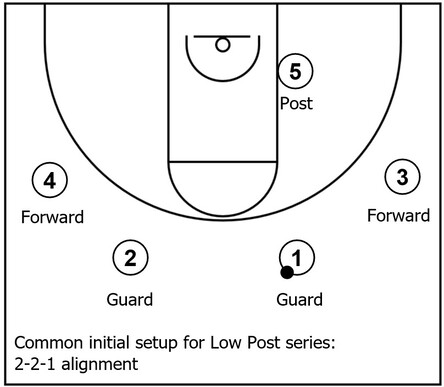
This is an example of the 2-2-1 alignment for the Low Post series.
Moreover, to give more clarity on the naming convention for the 2-2-1 alignment, the digits that are to the left or right of a dash (-) represents the number of offensive players located within a general region of the court.
What’s more, if a formation or alignment contains only one dash, then the number of players to the left of the dash would represent the front or top region while the number of players to the right of the dash would represent the back or bottom region.
In a similar fashion, if a formation or alignment contains two dashes, then the number of players to the leftmost of the dashes would represent the front or top region, the number of players in between the leftmost and rightmost dashes would represent the middle region, and the number of players to the rightmost of the dashes would represent the back or bottom region.
This could also apply to other formations or alignments as well.
So, with all that said, for the case of the 2-2-1 alignment, this means that there are two offensive players located at the front region (i.e. the slot areas), two offensive players located in the middle region (i.e. the wing areas), and one offensive player located in the back region (i.e. the low post area).
To be even more specific for this case, there are two guards (1 and 2) in the slots, two forwards (3 and 4) on the wings, and one traditional post player (5) who begins near the low post area on the strong side of the court.
In addition to that, this particular set could be generally referred to as a 2-guard front as well because there are specifically two guards located in the front region of the alignment/formation.
Common initial action to begin Low Post series
This section contains the common or typical initial action that the players could utilize to begin or trigger the Low Post series of Princeton offense.
It should be noted as well that while this particular example demonstrates the common way of initiating the Low Post series, it is quite possible that there could be other ways to start the offense as well.
Slot to wing pass, cut through, and low post feed
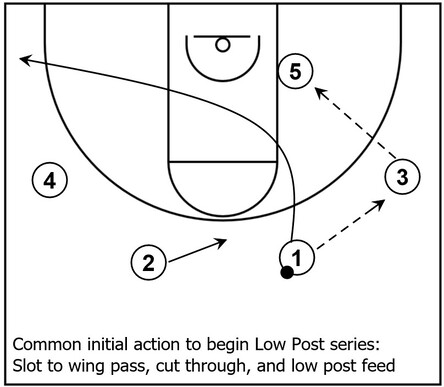
Essentially, the typical action to trigger the Low Post series of Princeton offense consists of a slot to wing (or guard to forward) pass followed up with a cut through to the opposite corner on the weak side by the player executing the first pass.
Afterwards, the wing or forward will attempt to feed the ball to the adjacent post player who is currently located near the strong side low post area.
It should be mentioned as well that these particular types of passes are generally called entry passes.
In essence, a pass that is thrown from the top or slot to the wing is commonly known as a wing entry pass.
Additionally, a pass that is thrown from a perimeter area such as the wing to the low post area is typically referred to as a post entry pass.
For the diagram above, 1 throws a pass with 3 as the receiver, shown with the dotted arrow.
Next, 1 cuts through to the opposite corner, and as that occurs, 5 receives the ball from 3, also displayed via the dotted arrow.
Moreover, 2, who was in the opposite slot of 1, can slide over towards the top area as well, mainly to space out the floor while also being prepared for additional actions of the Low Post series.
Transition/fast break variation
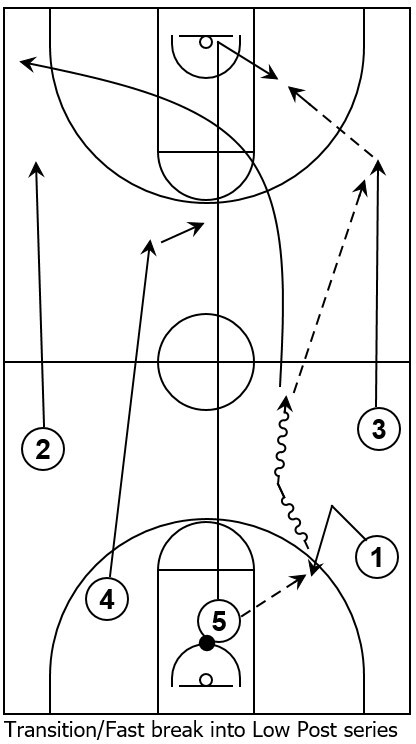
It is also possible for a team to start with a transition offense or fast break opportunity and then segue into the Low Post series.
In relation to the adjacent diagram above, let’s assume that the opposing team missed a shot, which allowed 5 to collect a defensive rebound near the basket in the offensive team’s backcourt.
Next, let’s say that 1 gets open with a V-cut and receives the ball from 5.
As that happens, 2, 3, and 4 begin to sprint into the offensive team’s frontcourt.
Furthermore, 1 dribbles toward the frontcourt as well, represented by the wavy arrow.
Eventually, 2 fills the left side wing while 4 initially settles in the left slot area.
Furthermore, 5 sprints as hard as possible directly to the front of the rim and then cuts down to the right side low post area.
While that is occurring, 1 throws a pitch ahead pass with 3 as the recipient and then cuts through and away to the left side corner.
Immediately following that action, 5 receives the ball from 3 while 4 cuts toward the top from the left slot area.
From there, the team is ready to attempt the various scoring options of the Low Post series.
Also, make note that 2 and 4 have switched spots on the floor when compared to the standard initial action where there would be a 2-guard front, specifically in the slot areas.
This is generally not a problem as both the guards and forwards will more than likely interchange perimeter spots on the court throughout the duration of the offense.
In most cases, the only player who will not change roles or areas on the court is the post player, also known as the center.
That particular player will usually operate near or around the post, especially the low post area, while the team is executing the Low Post series of Princeton offense.
Examples of primary scoring options for the Low Post series
This section contains examples of primary scoring options for the Low post series, particularly after the post player receives possession of the basketball from the wing.
It should also be mentioned that for each of the diagrams, unless otherwise noted, the common initial action has already occurred.
Therefore, the player who starts the action with the slot to wing or guard to forward pass (that being player 1 on the diagram) has already cut through to the weak side corner, opposite the ball.
Example 1: Laker cut
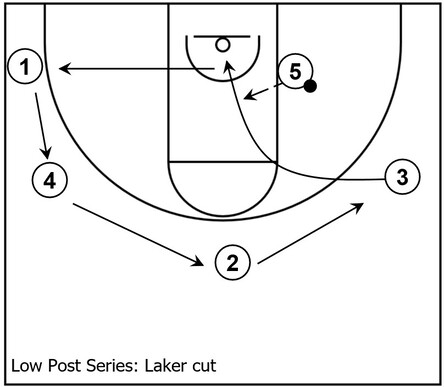
To begin this particular scoring option, 3 simply performs a Laker cut on the low side of 5 while 2 fills behind to occupy the vacant right side wing.
Afterwards, 3 could receive the ball from 5 and score via a layup around the basket, assuming that is open.
If it is not available, then 3 could continue to cut through to the left side corner while 4 occupies the top space and 1 fills the recently emptied left side wing.
From there, 2 could perform the Laker cut, similar to 3, or the team could run some other scoring option.
Example 2: Split cut and slip
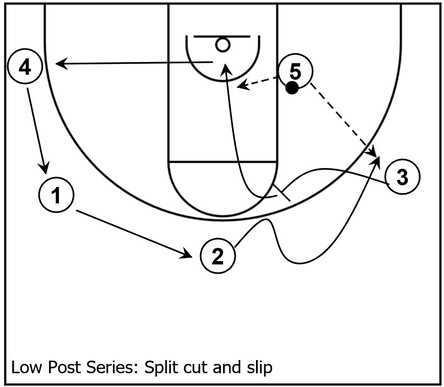
This example demonstrates a split cut, also referred to as a split screen or post split action, as well as a potential slip to the basket.
To begin, after making the post entry pass, 3 performs a split cut away from the ball to set a screen near the high post elbow area.
2 utilizes that screen and cuts to the vacant right side wing.
Also, 3 can slip the screen during or immediately following the cut of 2.
From there, 5 can pass to either 3 or 2 for potential scoring opportunities via a layup or jump shot respectively.
Additionally though, if 3 is not open, then 3 continues through to the left side corner while 1 fills the top and 4 occupies the left side wing area.
Example 3-1: Reject screen + pop out
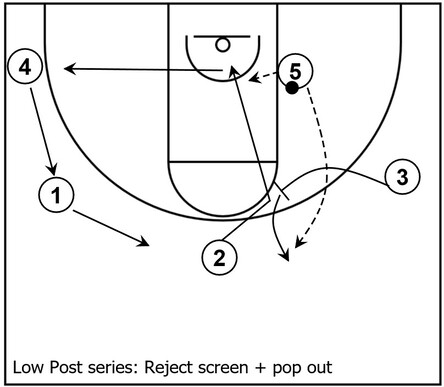
This example demonstrates screen rejection and pop action by the player executing the screen.
In essence, after the post entry pass from the common initial action, 3 performs the split cut away from the ball, similar to the previous example.
However, this time, 2 rejects the screen and immediately performs a backdoor cut towards the rim.
Furthermore, 3 pops out near the right slot following the rejection of the split screen.
Next, 3 could receive the ball from 5 and score via a layup near the basket.
Alternatively, 3 could receive the ball instead and take the open jump shot.
What’s more, if 2 doesn’t receive the ball, then 2 continues through to the left side corner while 1 fills the left slot and 4 occupies the left side wing.
Example 3-2: Step-up pick and roll
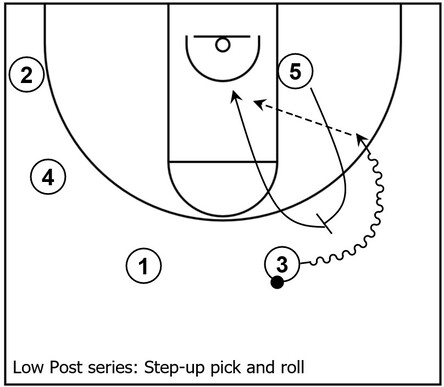
This example showcases a continuation of the previous diagram in which 2 cut to the left side corner and 3 received the ball but did not take the jump shot.
When that happens, 5 could lift from the low post area to set a step-up screen near the slot area.
3 can use that screen and dribble towards the baseline while 5 rolls to the basket.
Afterwards, 3 could take the mid-range jump shot if that is available or possibly pass the ball with 5 as the recipient.
Example 3-3: Step-up pick and pop
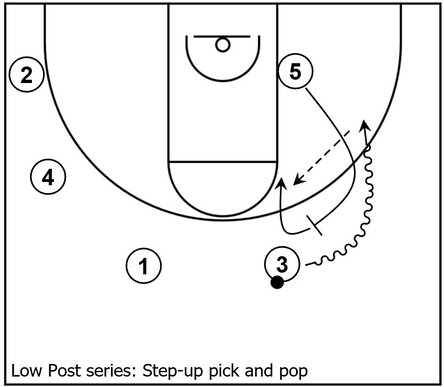
This example is essentially an alteration of the previous diagram.
This time, instead of rolling to the basket following the step-up screen, 5 could simply pop to a perimeter area.
For this case, 5 pops to the right side elbow area and receives the ball from 3, preferably via a pocket pass or hook pass.
Afterwards, 5 could take the open jump shot.
Default option for the post player
This section contains the default option for the post player, which could happen before or after other teammates cut or screen.
Basically, the post player could keep possession of the basketball and try to score points near the rim, particularly by way of a low post move.
Alternatively though, if the direct scoring opportunity is not available, then the post player could also perform a kick pass to other teammates, especially on the weak side of the court.
Score or kick out
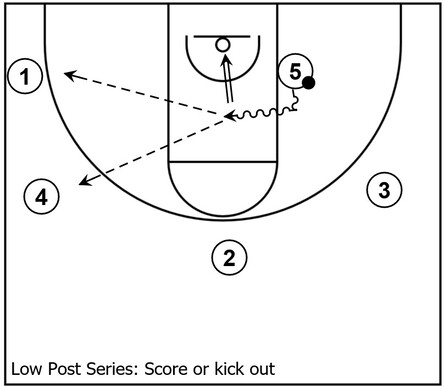
In reference to the diagram above, 3 has already entered the ball into the low post but for demonstrative purposes, 3 does not cut or screen away.
Instead, 5 dribbles into the paint, which is typically the preferred action, and performs a low post move such as a hook shot or up and under, represented by the wide arrow.
Alternatively though, if 5 is not able to take the shot for any reason, then 1 and 4 are available via the kick pass.
Related Links:
Campbell Fighting Camels – Princeton Offense – Low Post – YouTube